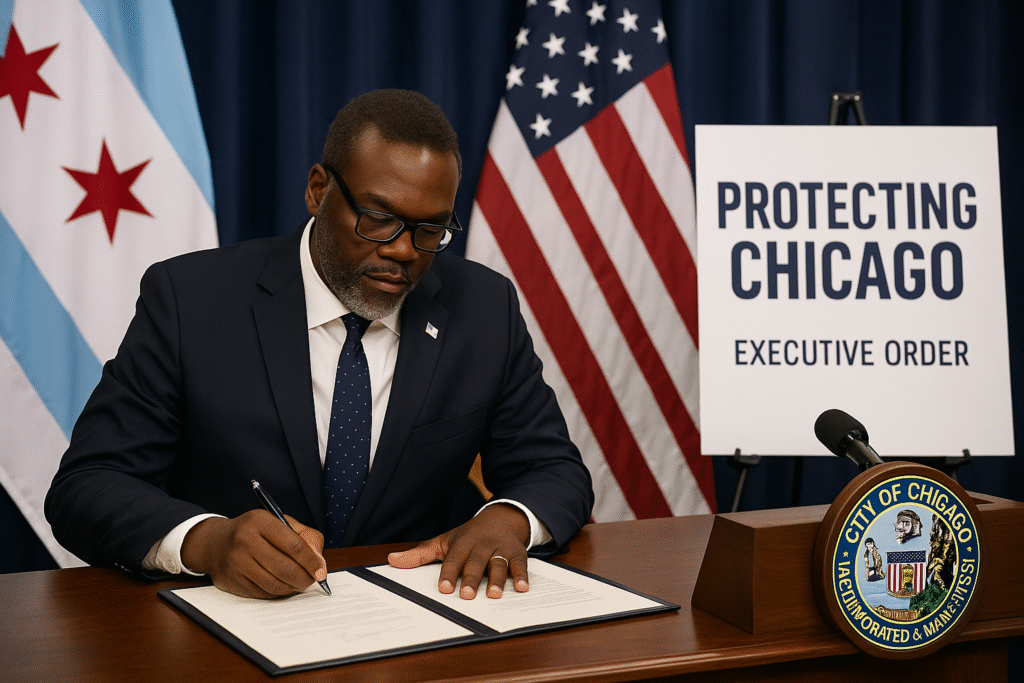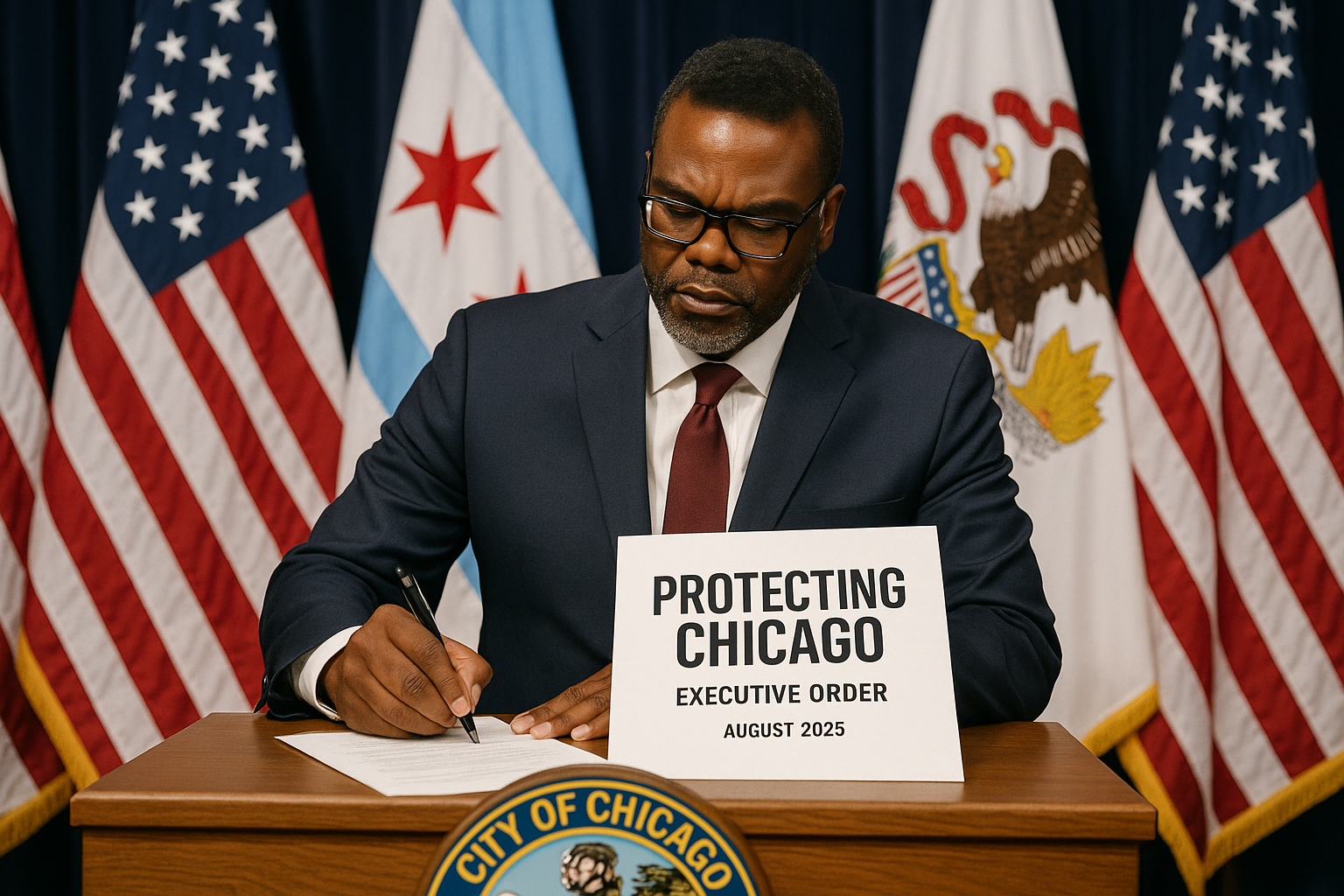Chicago Mayor Brandon Johnson signed the “Protecting Chicago” executive order at the end of August 2025 to block local police cooperation with any potential federal immigration raids, National Guard or other troop deployments. The order and the larger episode are now the center of a federal-local showdown — part legal, part political, and all high-stakes for residents, civil-liberties advocates and national politics. This post breaks it down step-by-step, explains what the order actually does, summarizes what Trump and others are saying, and lays out practical next steps and likely outcomes.
1) What the order actually says — the core measures (simple version)
Mayor Johnson’s executive order, described publicly as the “Protecting Chicago” initiative, instructs city departments to protect residents’ constitutional rights if federal agents or troops arrive. Key operational points that have been reported:
- Chicago Police Department (CPD) will not collaborate with federal agents on immigration enforcement, patrols, traffic stops, checkpoints, arrests or other joint policing activities. (AP News, Reuters)
- The order urges (and in some cases requires) clear identification: recommends that any federal agents operating publicly display agency, name/rank and badge numbers, and that body cameras be used when interacting with the public. It also restricts face coverings for officers except for medical/safety reasons and asks federal agents to refrain from donning masks. (CBS News, Straight Arrow News)
- The city will build a public “Know Your Rights” campaign and mobilize legal resources in anticipation of arrests or civil-immigration actions in “sensitive locations” (schools, hospitals, shelters, places of worship). (Straight Arrow News)
Those items are designed to limit cooperation — and visibility problems — if the federal government moves to expand ICE or military presence. The administration framed it as pre-emptive protection for immigrants and other vulnerable residents. (AP News)
2) Why the mayor did this — what triggered it
The order came in direct response to repeated statements from President Donald Trump and senior DHS officials indicating plans to expand immigration enforcement operations and, possibly, deploy National Guard or federalized troops in major cities — Chicago named specifically. Federal officials had already increased ICE presence in other cities earlier in the summer, and internal planning for a possible Chicago deployment raised alarm among city leaders. Johnson said he’d received “credible reports” that action could happen within days, prompting the rapid order. (AP News, Yahoo News)
3) What President Trump and the White House are saying
The administration has framed these moves as part of a nationwide “crackdown” on crime and illegal immigration; Homeland Security Secretary Kristi Noem publicly defended ramped-up ICE operations and argued federal resources are necessary. The White House described local officials’ pushback as politically motivated; a White House spokesperson dismissed Mayor Johnson’s order as a “publicity stunt,” urging local leaders to “focus on fixing crime.” President Trump himself has publicly criticized Chicago’s leadership and warned federal action could follow. (Reuters, Straight Arrow News)
4) How state and local leaders reacted
Illinois Governor J.B. Pritzker and Chicago officials strongly objected. Pritzker called an uncoordinated federal deployment “unconstitutional” and warned it would be met with legal and political resistance. Chicago’s mayor and other local leaders framed the administration’s posture as politically motivated and risky, arguing that federalized troops or militarized immigration arrests would inflame tensions and harm trust in law enforcement. Local aldermen supported the order as both a legal and moral firewall for immigrant communities. (The Guardian, CBS News)
5) What legal experts say — limits on presidential power and likely court fights
Deploying active-duty troops or federalizing the National Guard to perform civilian law-enforcement functions triggers a complicated legal web:
- Posse Comitatus Act (1878) generally forbids using the U.S. military for ordinary law enforcement; the Insurrection Act and other narrow statutory exceptions can allow exceptions in certain emergencies. Separate authorities (Title 10/12406) and federalization of Guards have been invoked in recent 2025 operations, and these questions are already subject to litigation. (Reuters)
- Courts are likely to see pre-emptive lawsuits if the White House tries to federalize troops or use active-duty forces for domestic enforcement without state cooperation. Legal scholars say federalization without clear statutory grounds would face a high bar and could be blocked — but litigation takes time and may not prevent on-the-ground activity in the short run. (Brennan Center for Justice, Reuters)

6) What civil-liberties groups and community groups are saying
National and local civil-rights organizations, including the ACLU and ACLU of Illinois, condemned the federal plans, calling them unnecessary, dangerous and likely to inflict harm on immigrant communities and people of color. Those groups are mobilizing legal resources, “know your rights” guides and hotlines, and warning residents about risks of indiscriminate detentions and erosion of constitutional protections. Community organizers are preparing protests and legal responses. (American Civil Liberties Union, ACLU of Illinois)
7) What people on the ground and experts worry about (practical risks)
- Trust in policing: Federalized raids or joint patrols seen as coercive can reduce community cooperation with local cops, making crime-fighting harder in the long term. (Reuters)
- Escalation risk: Past deployments (e.g., Los Angeles earlier in 2025) led to protests and complications; military leaders flagged operational risks when troops were used in civilian settings. That history raises concerns about mistakes, miscommunication and civil unrest. (Reuters)
- Targeting of vulnerable people: Immigrant families, people experiencing homelessness, and those in “sensitive locations” are particularly at risk of detention and disruption. The city’s order aims to reduce those harms, but only if legal protections and local non-cooperation hold. (Straight Arrow News)
8) Political consequences — why this matter nationally
This confrontation has quickly become a national political storyline:
- For the Trump administration: the moves play to a law-and-order base and offer a strong visual of federal action — useful politically ahead of 2026 campaigns. Supporters say deployments show decisive leadership. (Reuters)
- For Democrats and local leaders: the incident looks like an overreach that can energize voters worried about civil liberties and the federalization of policing. Critics call it political theater that targets Democratic cities to score partisan points. (The Guardian, Straight Arrow News)
Bottom line: even if court challenges limit federal options, the episode will drive headlines, shape voter perceptions and test the balance between federal power and local control. (Reuters)
9) What to watch next — timeline and likely outcomes
- Short term (days–weeks): expect more federal statements and logistical preparations (ICE staging, temporary logistics near Naval Station Great Lakes cited), continued local briefings, and rapid legal filings from city/state attorneys general if deployments proceed. (AP News, Reuters)
- If federal forces arrive: immediate deployment will likely trigger protests, rapid ACLU litigation and escalated political rhetoric; how the National Guard or active-duty forces are used (Title 32 vs Title 10 vs Insurrection Act) will determine legal vulnerability. (Reuters)
- Longer term: congressional oversight hearings, judicial rulings on the legality of deployments, and political fallout that could reverberate into the 2026 midterm cycle. (CalMatters)
Practical advice for Chicago residents (brief, non-legal)
- If you or someone you know is part of an immigrant community: review the ACLU and Chicago-city “Know Your Rights” resources; local legal hotlines are being set up. (ACLU of Illinois, Straight Arrow News)
- If you see federal agents operating: politely ask for identification; do not resist; call a lawyer or hotline if you are detained. (Straight Arrow News)
- Follow trusted local media (AP, Reuters, Chicago Tribune, WBEZ) for official updates and verified information rather than social media rumors. (AP News, Reuters)
Quick summary — three takeaways
- The Protecting Chicago executive order is an aggressive local effort to stop local cooperation with federal immigration operations and potential troop deployments. (Reuters)
- Trump and the White House present the federal effort as crime-fighting; local leaders and civil-liberties groups call it unnecessary, dangerous and politically driven. Expect legal fights. (Reuters, American Civil Liberties Union)
- The legal and operational lines are murky. How the federal government proceeds (ICE only vs National Guard vs active-duty troops) will determine both the legality and the political fallout. (Reuters)
Sources & further reading (key reporting I used)
- Reuters — “Chicago mayor says police will not aid federal troops or agents.” (Reuters)
- Associated Press — “Chicago mayor defies Trump’s immigration crackdown plan for the city.” (AP News)
- Washington Post / Guardian / Chicago Sun-Times reporting on the executive order and local reactions. (The Washington Post, The Guardian, Chicago Sun-Times)
- Reuters legal explainers and reporting on deployment law (Posse Comitatus / Insurrection Act). (Reuters)
- ACLU and ACLU of Illinois statements and “Know Your Rights” resources. (American Civil Liberties Union, ACLU of Illinois)
Disclaimer (Google AdSense–friendly)
This article summarizes reporting and public statements available as of September 1, 2025. It is for informational purposes only and does not provide legal advice. Readers should consult official city/state announcements and qualified legal counsel for decisions that affect personal legal status or safety. Images used in this article are royalty‑free or licensed for commercial use and are provided here for illustrative purposes.
